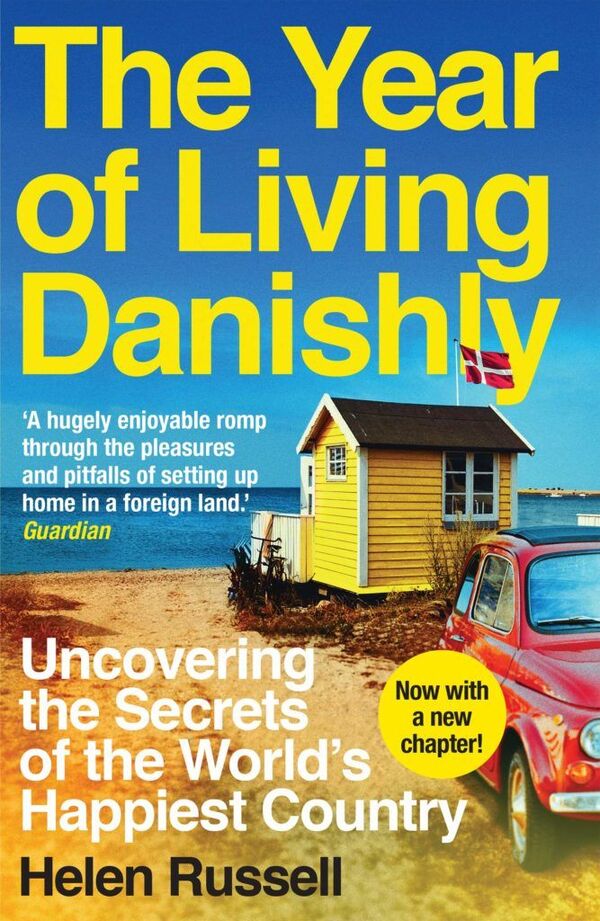
This book review of The Year of Living Danishly: Uncovering the Secrets of the World’s Happiest Country is one that is peppered with my own anecdotal input because its accounts are so practical that I wondered why I did not finish it the first time I picked it up in 2020.
I recently reacquainted myself with it again after a 2-year hiatus. One of the nice things about digital libraries is you can always browse through the record of books you have read before and then pick it up again, which is what I did with this particular book. The Year of Living Danishly is written by Helen Russell, and published in 2015 by Icon Books.
The Year of Living Danishly: Uncovering the Secrets of the World’s Happiest Country
This book started with the author moving to Denmark because her husband got a job there. I know Denmark as the land of wooden clogs and milkmaids, Ole Kristiansen’s Lego and of course Morten Frost, the great Danish badminton player. Frost wasn’t quite my favourite player, but after reading this book, I think I can sort of understand why a country of less than 6 million people can produce so many great badminton players, including the current Viktor Axelson.
The reader is brought along Helen’s journey to understand what makes Danish people so happy. At the time of the writing of her book, Denmark had the honour of being the happiest country in the world. So her journey of living Danishly chronicled her search for that happiness that the Danes were so well-known for. At the time of the writing of her book, Denmark had the honour of being the happiest country in the world.
Helen Russell, the author is British. Living Danishly was made possible because her Lego Man got a job in Denmark. The moniker she gave him is the giveaway which company he was working for. I’ve always known Denmark as one of the Nordic countries but it wasn’t until I read this book that I realised that their winter was freezing cold, at more than -10 degrees or that the whole country goes into a hygge, sort of a cozy hibernation mode where most Danes would just make themselves comfortable at home because it was so cold outside. Hygge also, apparently contributes a great deal to the high level of happiness among Danes.
| Did you know? Hygge is a Danish term defined as a quality of cosiness and comfortable conviviality that engenders a feeling of contentment or well-being. Pronounced “hoo-guh,” the word is said to have no direct translation in English, though “cozy” comes close. It derives from a sixteenth-century Norwegian term, hugga, meaning “to comfort” or “to console,” which is related to the English word “hug.” Associated with relaxation, indulgence, and gratitude, hygge has long been considered a part of the Danish national character. |
What works in Denmark that makes a happy Dane?
This book is a nice read because Denmark seems to go against many conventions of life. Long hours of work which we are so accustomed to is not common in Denmark. It is also a country where people are very happy, despite the freezing cold and high taxes. FYI, Danes pay up to 45% of their income in return for a wide social net which takes care of their health, education and well-being.
Working for passion vs working to survive
As for why I understood better why a country with such a small population can produce so many great badminton players? Well, in Denmark you are encouraged to work in a job that you like. They have a great system where you can quit your job and be retrained for something that you like. Furthermore, you can have up to 2 years to do that. During that time, you will be given 80 percent of your last drawn salary.
In the book there was even a mention of a porn actor getting himself retrained to be an accountant. How about that? To have that in many other countries would have been quite improbable because there is simply no safety net for you to switch a job while being retrained.
A home should be a place to be comfortable and to recharge
Things highlighted by the author, such as the attention to the aesthetics that contribute to comfortable homes caught my attention. Danes pay a lot of attention to making their homes comfortable. As I read on, I can see why too. Danes spend half a year indoors during the winter season. When you do that much of time at home, a nice home is important to keep you sane.
Living Danishly means paying close attention to making your den as comfy and pleasing to the eye as possible. This makes perfect sense to me. I mean, wouldn’t anyone like to come home to a home that is pleasing in every sense of the word.
Good environment, good life
Danes are fierce environmentalists, and I love this part a lot. Living in Malaysia where a great number of her people still seem to be oblivious to the harm of wasteful living makes me appreciate the Danes way of living together with nature. Living Danishly means abiding by all these rules about what you can pick from the forest for Christmas decorations. Danes are very into sustainability and this is what everyone should aim for.
An interesting note is how children are exposed to animal slaughters from a young age. Museums hold dissections of animals for school children to see. In my opinion, it is really a practical thing to do. Most of us are squeamish about an animal being killed. Yet, we still eat meat. We tend to look at every animal from the perspective of Bambi and it is a very unrealistic approach. Kids today will go all agog at the sight of an animal being slaughter and yet not flinched an eye when they sink their teeth into a KFC fried chicken. It is something of a paradox.
Gender equality
Gender equality is important in Denmark. I find it fascinating that new parents get a total of 52 weeks maternity off, to be split between the couple. Childcare is heavily subsidised by the state and children seems to be as much the state’s responsibility as their own parents. Denmark is among the earliest countries to push for equality and women’s emancipation.
In Denmark, women eat! Most of us are bombarded by the ‘culture of thin’ for women. It is nice to read that there are still countries where women can just be human, i.e. they eat and not worry about being normal size. Danish women are described as stocky and well-built.
The resilient Dane
Also. you get to feel the resilience of the Danes through the experience of the writer. With half a year of winter, anyone who has done a little psychology will surely be able to see how easy it is for Danes to fall into the abyss of depression. Winter is depressing. Daylight hours are cut short and Danes have a lot of that! Long winters can turn us all into lunatics. And apparently, living Danishly is the antidote to all that dark and dreary weather.
The right happy priority
Yet the Danes have managed to work around that and come out as among the happiest people on this planet. This happiness-chase in A Year of Living Danishly by the author is probably what kept me glued to this book cos I found it intriguing that happiness apparently can be scaled.
The Danes reiterate the fact that money can’t buy happiness. Money is important but after a certain figure that allows our needs to be met, the extra just don’t buy any extra happiness. Beyond the needs, the wants are just that – wants that give you momentary happiness which dissipates rather quickly with each new purchase. Living Danishly highlights this fact.
As you read on though, it becomes clearer that happiness has a root cause. Trust. Living Danishly means paying high taxes too. Danes are okay with that because they trust their government to do the best for them. Danes are happy because they don’t spend all their life slogging away at work. Companies trust their employees to give their best at work. Living Danishly apparently also means that there is a balance between work and play. Not everything about life is all about work. A typical work day ends at 4.30 p.m. In July, the whole country goes on holiday.
An egalitarian society
The Danish society is egalitarian. Everyone does their fair bit for everything. Bicycles rules! Status is not displayed though car ownership. Status is not felt so much because of the high taxes paid. Those who earn more pay more. A butcher, an accountant, a cook can be found living on the same street.
During winter, even the Prime Minister shovels the snow to clear her yard. They have this law that everyone must clear their compound of snow and the Prime Minister joins the rest of Denmark in doing that. That’s living Danishly.
Remember that I wrote about trust in the Danish society? Trust begets safety. And living Danishly also means that it is okay to leave your baby in the pram outside a premise while you grab something from the store. Trust and safety go hand in hand in this land of the Vikings. This reminds me of my days in Baling, Kedah about 3 decades ago when it was also perfectly safe to leave the keys of your car in its ignition and no one will steal it. The trust level was that high.
But… high divorce rates.
The Danes have high divorce rates too. A peculiar thing to note is how the writer unearths the fact that a lot of divorces happen in August, after the month long holiday when summer starts. Apparently, a month long holiday helps to seal the fate of many couples as being together with nothing else to occupy their time makes them see the differences that have grown. Yet all these divorces don’t seem to put a dampener to the happiness of the people because living Danishly is also about being open about one’s own happiness.
So what makes this book such a good read?
Well, for one, The Year of Living Danishly: Uncovering the Secrets of the World’s Happiest Country is a book that gives hope that there are places still on earth where there is a real balance in life. Companies work their employees way too much.
Yet in this one seemingly cold country which is inhospitable for half a year, her citizens are happy. Striking a balance, making trust a way of life and taking care of the welfare of the people – these are what creates happiness. One more thing, when those areas are looked into, the role of religion diminishes too. Living Danishly works so well that the Danes are consistently among the happiest people on our planet.
The Year of Living Danishly: Uncovering the Secrets of the World’s Happiest Country is one of those books that I would highly recommend for the glimmer of hope that life can indeed be good on this earth.
Check out also:
Get the book at Kinokuniya Malaysia!
If you’re interested in reading The Year of Living Danishly: Uncovering the Secrets of the World’s Happiest Country, you can get your copy from Kinokuniya Malaysia online.
Denmark is officially the happiest nation on Earth, so when journalist Helen Russell finds herself spending a year in rural Jutland, she decides she’ll do all she can to uncover the secrets of the Danes’ happiness. But will the long, dark winters and pickled herring take their toll?
The Year of Living Danishly: Uncovering the Secrets of the World’s Happiest Country




